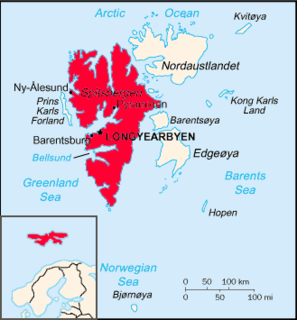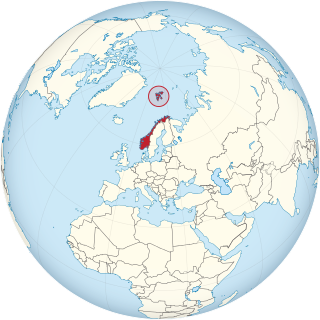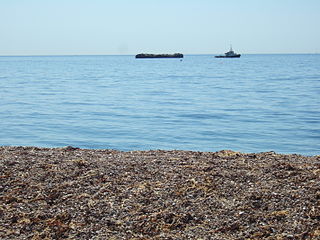Related Research Articles

Svalbard, also known as Spitsbergen, or Spitzbergen, is a Norwegian archipelago in the Arctic Ocean. North of mainland Europe, it is about midway between the northern coast of Norway and the North Pole. The islands of the group range from 74° to 81° north latitude, and from 10° to 35° east longitude. The largest island is Spitsbergen, followed by Nordaustlandet and Edgeøya. The largest settlement is Longyearbyen.

Spitsbergen is the largest and only permanently populated island of the Svalbard archipelago in northern Norway.

Bear Island is the southernmost island of the Norwegian Svalbard archipelago. The island is located in the western part of the Barents Sea, approximately halfway between Spitsbergen and the North Cape. Bear Island was discovered by Dutch explorers Willem Barentsz and Jacob van Heemskerck on 10 June 1596. It was named after a polar bear that was seen swimming nearby. The island was considered terra nullius until the Spitsbergen Treaty of 1920 placed it under Norwegian sovereignty.

Svalbard and Jan Mayen is a statistical designation defined by ISO 3166-1 for a collective grouping of two remote jurisdictions of Norway: Svalbard and Jan Mayen. While the two are combined for the purposes of the International Organization for Standardization (ISO) category, they are not administratively related. This has further resulted in the country code top-level domain .sj being issued for Svalbard and Jan Mayen, and ISO 3166-2:SJ. The United Nations Statistics Division also uses this code, but has named it the Svalbard and Jan Mayen Islands.

Longyearbyen is the world's northernmost settlement and largest inhabited area of Svalbard, Norway. It stretches along the foot of the left bank of the Longyear Valley and on the shore of Adventfjorden, the short estuary leading into Isfjorden on the west coast of Spitsbergen, the island's broadest inlet. As of 2002 Longyearbyen Community Council became an official Norwegian municipality. It is the seat of the Governor of Svalbard. The town's mayor is Arild Olsen.

Operation Gauntlet was an Allied Combined Operation from 25 August until 3 September 1941, during the Second World War. Canadian, British and Free Norwegian Forces landed on the Norwegian island of Spitsbergen in the Svalbard Archipelago, 650 mi (1,050 km) south of the North Pole.

The Svalbard Treaty recognises the sovereignty of Norway over the Arctic archipelago of Svalbard, at the time called Spitsbergen. The exercise of sovereignty is, however, subject to certain stipulations, and not all Norwegian law applies. The treaty regulates the demilitarisation of the archipelago. The signatories were given equal rights to engage in commercial activities on the islands. As of 2012, Norway and Russia make use of this right.

Pyramiden is an abandoned Soviet coal mining settlement on the Norwegian archipelago of Svalbard which has become a tourist destination. Founded by Sweden in 1910 and sold to the Soviet Union in 1927, Pyramiden was closed in 1998 and has since remained largely abandoned with most of its infrastructure and buildings still in place, the cold climate preserving much of what has been left behind.

The Norwegian Polar Institute is Norway's central governmental institution for scientific research, mapping and environmental monitoring in the Arctic and the Antarctic. The NPI is a directorate under Norway's Ministry of Climate and Environment. The institute advises Norwegian authorities on matters concerning polar environmental management and is the official environmental management body for Norwegian activities in Antarctica.

Operation Zitronella, also known as Unternehmen Sizilien, was an eight-hour German raid on Spitzbergen, in the Svalbard Archipelago, on 8 September 1943. The battleships Tirpitz and Scharnhorst, plus nine destroyers, sailed to the archipelago, bombarded Allied-occupied settlements in Isfjorden and covered a landing party. Six Norwegians were killed and 31 were taken prisoner; sixteen Germans were wounded, one dying of his wounds.

The Svalbard Global Seed Vault is a secure backup facility for the world's crop diversity on the Norwegian island of Spitsbergen in the remote Arctic Svalbard archipelago. The Seed Vault provides long-term storage of duplicates of seeds conserved in genebanks around the world. This provides security of the world's food supply against the loss of seeds in genebanks due to mismanagement, accident, equipment failures, funding cuts, war, sabotage, disease and natural disasters. The Seed Vault is managed under terms spelled out in a tripartite agreement among the Norwegian Government, the Crop Trust, and the Nordic Genetic Resource Center (NordGen).
Nymark was the name that artist Alex Hartley gave to a small island he discovered in the arctic archipelago of Svalbard, a Norwegian territory, in 2004. It is officially named Nyskjeret by the Name Committee for Norwegian Polar Regions. It is a small island in the Barents Sea, 500 miles off the coast of Norway. It emerged from the now melted portion of a retreating glacier and is around the size of a football field.

Operation Fritham was an Allied military operation during the Second World War to secure the coal mines on Spitsbergen, the main island of the Svalbard Archipelago, 650 mi (1,050 km) from the North Pole and about the same distance from Norway. The operation was intended to deny the islands to Nazi Germany.

The economy of Svalbard is dominated by coal mining, tourism and research. In 2007, there were 484 people working in the mining sector, 211 people working in the tourism sector and 111 people working in the education sector. The same year, mining gave a revenue of 2.008 billion kr, tourism NOK 317 million and research 142 million. In 2006, the average income for economically active people was NOK 494,700, or 23% higher than on the mainland. Almost all housing is owned by the various employers and institutions and rented to their employees; there are only a few privately owned houses, most of which are recreational cabins. Because of this, it is nearly impossible to live on Svalbard without working for an established institution. The Spitsbergen Treaty and Svalbard Act established Svalbard as an economic free zone and demilitarized zone in 1925.
Novelists, screenwriters and filmmakers have set their works in Svalbard, an archipelago in the Arctic, the northernmost part of Norway yet closer to Greenland. Such works often make use of its Arctic climate, polar bears, isolation and the natural beauty of its dominant glaciers, mountains and fjords.
Camp Morton was a coal mining encampment on Spitsbergen island in the Svalbard archipelago, Norway. It was located on the northern shores of Van Mijenfjorden, near the sea entrance. It was part of an effort by British investors and entrepreneurs to extract resources from Spitsbergen, at that time open to various nations' claims for development.
Arctic Coal Company was a coal mining company that operated mines at Longyearbyen in Svalbard, Norway, between 1906 and 1916.

Nowhereisland was an artwork by artist Alex Hartley, produced by the Bristol-based arts organisation, Situations. Nowhereisland was an ‘Artists Taking the Lead’ project, funded by Arts Council England as part of the London 2012 Cultural Olympiad.

The Ny-Ålesund Town and Mine Museum is a museum located in Ny-Ålesund, a town on Spitsbergen, the central island of the Norwegian archipelago Svalbard in the Arctic Ocean. While some sources claim that the more well known Svalbard Museum holds the position, the museum is the world's northernmost such by virtue of Ny-Ålesund's position to the far north of the regional capital Longyearbyen.
The Arctic World Archive (AWA) is a facility for data preservation, located in the Svalbard archipelago on the island of Spitsbergen, Norway, not far from the Svalbard Global Seed Vault. It contains data of historical and cultural interest from several countries, as well as all of American multinational company GitHub's open source code, in a deeply buried steel vault, with the data storage medium expected to last for 500 to 1,000 years. It is run as a profit-making business by private company Piql and the state-owned coal-mining company Store Norske Spitsbergen Kulkompani (SNSK).
References
- ↑ "PRIX COAL 2015 : COAL" . Retrieved 21 February 2019.
- Britânico quer criar uma república no Ártico (Agence France-Presse, in Portuguese)